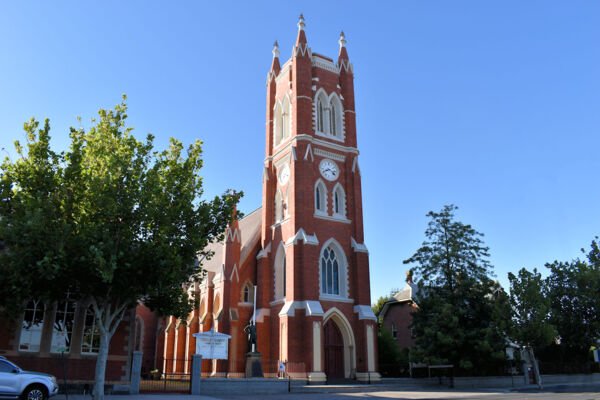Bendigo, VIC - St Paul's Anglican Cathedral
Year Built: 1873
Denomination: Anglican
Saint: Paul
Address: Myer's Street, Bendigo, Victoria, 3550
Architect: Robert Alexander Love
Architectural Style: Gothic Early English
Traditional Owners: Dja Dja Wurrung people
Last Updated: 21/02/2024
History and Architecture:
The cathedral was designed by the architect Robert A. Love. The nave was dedicated in November 1868, the bell tower in 1873 and the chancel and transepts in 1927. Originally a parish church, St Paul's became the diocese's cathedral in 1981.
The building is constructed of red brick with stone dressings in an early Gothic style and is laid out in a simple cruciform plan comprising a six bay nave, transepts and sanctuary. Internally the cathedral is decorated with stained glass windows, several wooden sculptures and an opus sectile reflecting a high church tradition.
The cathedral is a significant example of the Early English Gothic style.
St Paul's peal of eight bells was cast by Mears & Stainbank of London which arrived on the Cutty Sark. They were first rung on Good Friday, 10 April 1873.
The Cathedral was closed in 2009 due to structural issues. A fund is currently running to raise funds for restoration works.
Clergy:
This list may not contain every serving cleric, past or present, for this church.
Further submissions welcomed.
| Years | Name | Annotation | D.o.B | D.o.D |
|---|---|---|---|---|
| 1918 - 1919 | Rev Philip Peters Agnew | 1816 | 1885 | |
| 1993 - | Rev Graeme Stanley Perkins | |||
| 2014 - | Very Rev J Roundhill | |||
| 2019 - | Very Rev Dean Elizabeth Dyke |
Organ:
The Organ was built in 1883 by Alfred Fuller. It had 2 manuals, 22 speaking stops, 3 couplers, mechanical action. Rebuilt & enlarged in 1957 by Hill, Norman & Beard (Australia) Pty Ltd incorporating J.W. Whiteley console and Hill Violon 16 from St Andrew's Cathedral, Sydney. Renovated in 1995 by the Australian Pipe Organs Pty Ltd replacement J.W. Walker console from St George's Anglican Cathedral, Perth, solid state switching. It has 3 manuals, 39 speaking stops, 15 couplers, electro-pneumatic action.
A full description can be seen here.
Source:
1. Organ Historical Trust of Australia with permission.
